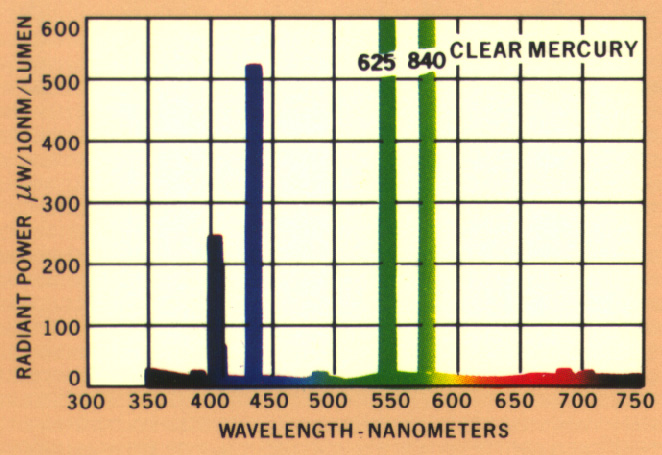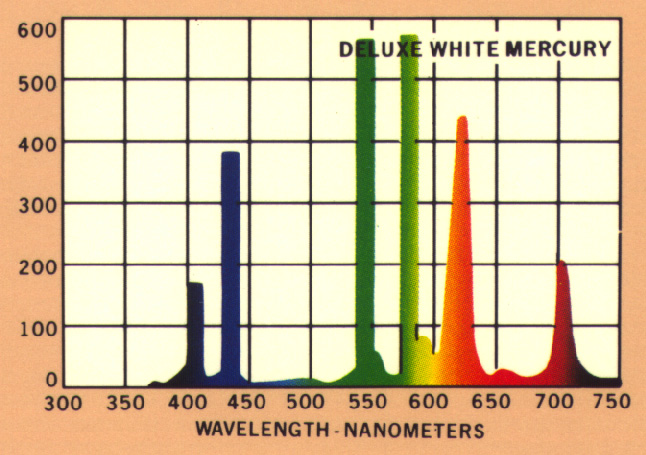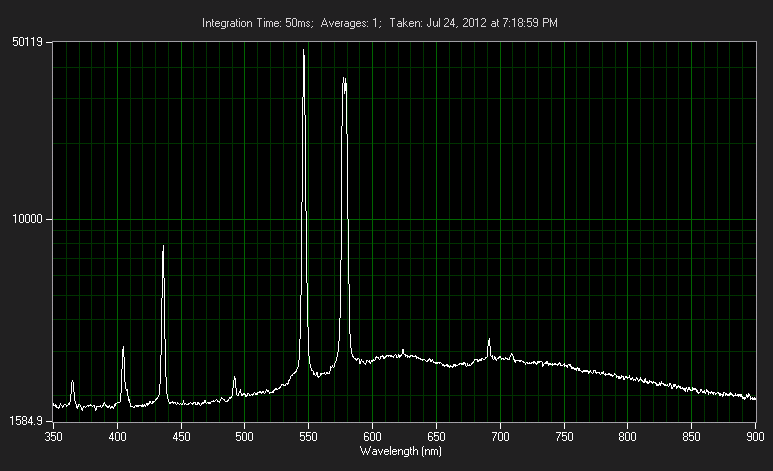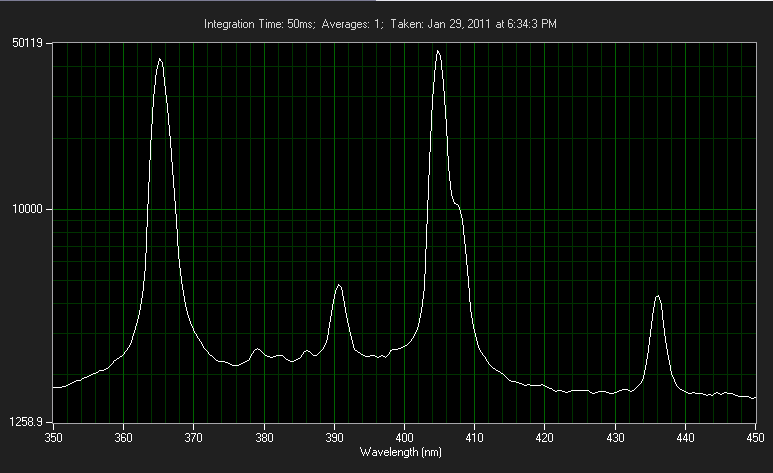Sigurthr
0
- Joined
- Dec 11, 2011
- Messages
- 4,364
- Points
- 83
Just another thread about photons! In this case there is a central arc tube made of fused quartz (high temp handling and transparent to UV) which is filled with low pressure argon and a bit of mercury metal. The glow discharge of the argon heats the mercury until the pressure rises and a power arc forms. This arc produces the main emission with characteristic lines of Hg - copious in the UV spectrum. Emission lines detectable for me are:
313nm 365nm 405nm 435nm 486nm 546nm 577nm 579nm 611nm
there are a few lines above 700nm which I can strongly see too, but I can't find sources which clearly label them as the IR Hg spectrum isn't very important to most people/uses.
Recently the High Pressure Mercury yard lamp my wife's family put up in the 1970s failed and I installed a Low Pressure Sodium lamp in its place. This worked excellently as LPS has a higher efficacy than hp-Hg and since color rendition is irrelevant in this application there is no downside to purely monochromatic light.
Well, messing around with an old mercury lamp rekindled my love for the Hg emission spectra. I got a great deal on a very inexpensive 100W all-in-one Hg lamp assembly and installed it over my work bench in my office. I've really been needing a lamp here as the room's lighting is behind me when I'm at my desk and I cast shadows over my work area.

Now my camera makes it look a lot colder and bluish-green than it really is. In fact, it looks pure white to my eyes, with no detectable blue/green tint. It is also brighter than the camera lets on, as it tries to darken the image when pointed at the lamp. Though, as stated elsewhere I have an extended spectral response. I can see emission lines well beyond 700nm from this lamp, so to me it isn't missing nearly as much of the red spectrum. The lamp housing stops all lines below the 405nm Hg line from passing, but I can still detect some of the 365nm faintly when checking the spectra. If I remove the front cover I can see it much stronger. The outer envelope of the lamp severely attenuates anything below 350nm, but fluorescence identifies at least some minor 254nm/264nm/313nm components leaking through, even though they are too washed out for me to see even the 313nm line.
Color rendition with this lamp is diminished, though I can clearly see the difference in colored items without any problem. Due to only a rather weak 611nm line emission red objects look a bit maroon or purple due to the lack of emission lines in their peak reflectance range. If you can't see the >700nm lines as well it looks even darker. Plenty good for my intended application though.
Upon further investigation I determined the mode of failure on the old 175W Hg yard lamp (which was dimmer than the new 55W LPS, and less effective) and was able to repair the ballast and get the old bird working again. I had destroyed the old bulb as it was definitely EOL at nearly 40years of service.
I hadn't tested out the new bulb my mother in law grabbed from the hardware store yet though, as obviously I had no way to power it with the ballast broken. To my surprise it turned out to be a diamond in the rough; this is a color corrected 175W Hg lamp! She paid only $15 from the local hardware store that had it sitting on the shelf since "before the clerk started working there in the 90's". These lamps forfeit some of the 405nm and 435nm emission of normal bulbs for enhanced >610nm emission which "warms up" the color and provides greatly enhanced color rendition. There is a phosphor coating inside of the outer envelope instead of a diffusing white layer like normal, or clear like in the case of the 100W lamp above. The trade off is less lumens per watt. This 175W lamp only puts out 5000lm, where as the 100W clear envelope one puts out 4700lm.
I'm going to have to build a wooden enclosure for this lamp ballast and find a suitable way of mounting it. I'm going to put this lamp to good use!

Note the lack of bluish-green tinge - same camera in use.
Observing the spectra from this lamp shows a greatly reduced 435nm line and a greatly enhanced 610nm line. Yep, that'll warm things up! Also of note, I can't detect any <405nm from this bulb.
These two lamps when used together are close to ideal lighting for my work room. I like "colder" lightscapes with high luminosity. I can't stand "warm glow" fluorescents or low wattage incandescents. Also, the "high" emission of UVA and NUV from these lamps stimulate vitamin D production without the sunburn hazards present when using low pressure Hg lamps ("sun lamps") or going out in the sun.
313nm 365nm 405nm 435nm 486nm 546nm 577nm 579nm 611nm
there are a few lines above 700nm which I can strongly see too, but I can't find sources which clearly label them as the IR Hg spectrum isn't very important to most people/uses.
Recently the High Pressure Mercury yard lamp my wife's family put up in the 1970s failed and I installed a Low Pressure Sodium lamp in its place. This worked excellently as LPS has a higher efficacy than hp-Hg and since color rendition is irrelevant in this application there is no downside to purely monochromatic light.
Well, messing around with an old mercury lamp rekindled my love for the Hg emission spectra. I got a great deal on a very inexpensive 100W all-in-one Hg lamp assembly and installed it over my work bench in my office. I've really been needing a lamp here as the room's lighting is behind me when I'm at my desk and I cast shadows over my work area.

Now my camera makes it look a lot colder and bluish-green than it really is. In fact, it looks pure white to my eyes, with no detectable blue/green tint. It is also brighter than the camera lets on, as it tries to darken the image when pointed at the lamp. Though, as stated elsewhere I have an extended spectral response. I can see emission lines well beyond 700nm from this lamp, so to me it isn't missing nearly as much of the red spectrum. The lamp housing stops all lines below the 405nm Hg line from passing, but I can still detect some of the 365nm faintly when checking the spectra. If I remove the front cover I can see it much stronger. The outer envelope of the lamp severely attenuates anything below 350nm, but fluorescence identifies at least some minor 254nm/264nm/313nm components leaking through, even though they are too washed out for me to see even the 313nm line.
Color rendition with this lamp is diminished, though I can clearly see the difference in colored items without any problem. Due to only a rather weak 611nm line emission red objects look a bit maroon or purple due to the lack of emission lines in their peak reflectance range. If you can't see the >700nm lines as well it looks even darker. Plenty good for my intended application though.
Upon further investigation I determined the mode of failure on the old 175W Hg yard lamp (which was dimmer than the new 55W LPS, and less effective) and was able to repair the ballast and get the old bird working again. I had destroyed the old bulb as it was definitely EOL at nearly 40years of service.
I hadn't tested out the new bulb my mother in law grabbed from the hardware store yet though, as obviously I had no way to power it with the ballast broken. To my surprise it turned out to be a diamond in the rough; this is a color corrected 175W Hg lamp! She paid only $15 from the local hardware store that had it sitting on the shelf since "before the clerk started working there in the 90's". These lamps forfeit some of the 405nm and 435nm emission of normal bulbs for enhanced >610nm emission which "warms up" the color and provides greatly enhanced color rendition. There is a phosphor coating inside of the outer envelope instead of a diffusing white layer like normal, or clear like in the case of the 100W lamp above. The trade off is less lumens per watt. This 175W lamp only puts out 5000lm, where as the 100W clear envelope one puts out 4700lm.
I'm going to have to build a wooden enclosure for this lamp ballast and find a suitable way of mounting it. I'm going to put this lamp to good use!

Note the lack of bluish-green tinge - same camera in use.
Observing the spectra from this lamp shows a greatly reduced 435nm line and a greatly enhanced 610nm line. Yep, that'll warm things up! Also of note, I can't detect any <405nm from this bulb.
These two lamps when used together are close to ideal lighting for my work room. I like "colder" lightscapes with high luminosity. I can't stand "warm glow" fluorescents or low wattage incandescents. Also, the "high" emission of UVA and NUV from these lamps stimulate vitamin D production without the sunburn hazards present when using low pressure Hg lamps ("sun lamps") or going out in the sun.










